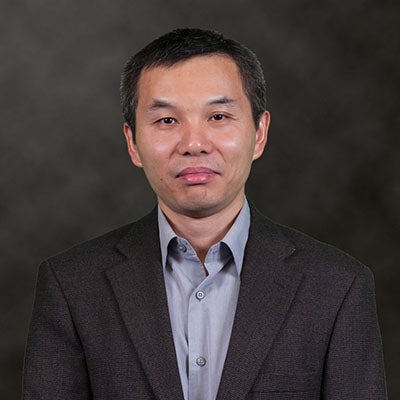Ma makes important breakthrough in understanding protein function
text block Heading link

Researchers at UIC’s Richard and Loan Hill Department of Biomedical Engineering have made an important breakthrough in understanding how proteins function. For the first time, Associate Professor Ao Ma and his graduate students Shanshan Wu and Huiyu Li have been able to identify the exact reaction coordinates (RCs) of the conformational change vital for the function of the HIV protease, a complex protein and important drug target.
The discovery was made by using a generalized work functional method they developed. This new method allows the researchers to rigorously calculate the RCs based on the principles of fundamental physics, as opposed to the conventional approach of trial-and-error or machine learning methods pursued by most researchers in the field.
Ma said this research will have far-reaching implications for both biomedical and protein engineering. Most diseases are due to malfunctions of proteins and a comprehensive understanding of how proteins function is crucial for designing drugs, fighting drug resistance, and developing artificial enzymes that can complete desired functions.
He added that RCs hold the key to this understanding, and the method developed by the Ma group marks a significant step for creating new drugs and novel enzymes.
“RCs tell you why these malfunctions happen because it tells you how these functionally important conformation dynamics happen,” Ma said. “If a mutation interferes with this, then we can understand how it interrupts function.”
“If you don’t know how these things happen, you can never understand why certain mutations cause malfunctions,” Ma said. “These malfunctions modify the conformational dynamics. If any mutation interferes with function, it will get eliminated by evolution, but that doesn’t tell you why it happens.”
RCs are a critical physical property of protein molecules and control their functions. Finding the RCs in complex molecules has been a goal in molecular biophysics for decades. Pioneering works by Rose Du and her team at the Massachusetts Institute of Technology and Harvard University first clarified the importance of RCs in protein folding in the late 1990s, and David Chandler’s group at University of California Berkeley established the importance of RCs in activated processes.
Previous scientists had only been able to find the exact RCs for small peptides. The work by Ma and his team is the first time that RCs were successfully identified for a complex protein, which he said marks a significant leap forward in the field.
Ma explained that the HIV protease has 198 residues and thousands of coordinates, its structural dynamics and function are controlled by six RCs. Each RC involves highly cooperative motions of hundreds of dihedral angles that engage the entire protein backbone.
“The small number of RCs and their high collectiveness are the underlying reason that enzymes can carry out their functions in a highly regular manner, which is critical for fulfilling their functional roles in cells,” Ma said.
This paper describing the research, “Exact Reaction Coordinates for Functional Protein Dynamics: Flap Opening in HIV-1 Protease” was published in the Proceedings of the National Academy of Sciences of the United States of America.